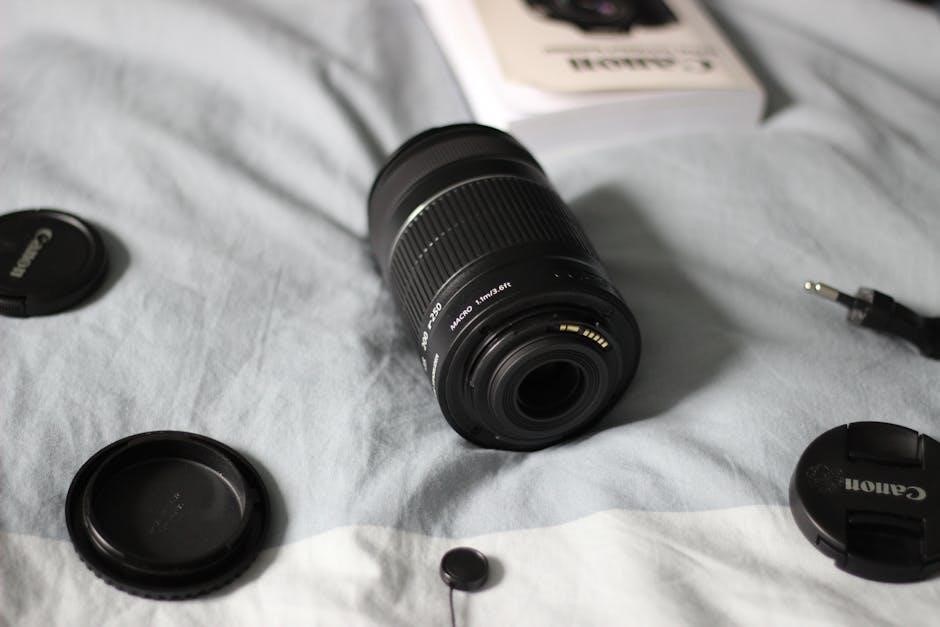The Canon EOS 7D is a high-performance DSLR camera designed for enthusiasts and professionals, offering advanced features like an 18.0 MP CMOS sensor and Dual DIGIC 4 processing.
Overview of the Canon EOS 7D Camera
The Canon EOS 7D is a high-performance DSLR camera designed for photography enthusiasts and professionals. It features an 18.0-megapixel CMOS sensor, Dual DIGIC 4 image processors, and a weather-sealed magnesium alloy body. The camera offers 8fps continuous shooting, a 3-inch LCD screen, and advanced autofocus with 19 cross-type AF points. It supports Full HD video recording and includes manual audio level control. Firmware updates enhance functionality, such as improving autofocus and adding features like manual audio adjustment for videographers. The EOS 7D is a versatile tool for capturing high-quality stills and videos.
Key Features and Specifications
The Canon EOS 7D features an advanced 18.0-megapixel APS-C CMOS sensor and Dual DIGIC 4 image processors, delivering exceptional image quality and fast performance. It offers continuous shooting at up to 8fps and a 19-point all-cross-type AF system for precise focus. The camera includes a 3-inch LCD screen, ISO range of 100-6400 (expandable to 12800), and Full HD video recording at 24/25/30fps. Weather-sealed construction ensures durability, while manual audio level adjustment enhances videography capabilities, making it a robust choice for enthusiasts and professionals alike.

Setting Up Your Canon EOS 7D
Setting up your Canon EOS 7D involves unboxing, initial configuration, and installing essential software and firmware for optimal performance and functionality.
Unboxing and Initial Setup
Unboxing the Canon EOS 7D reveals the camera body, EF-S 18-135mm lens, battery, charger, and manuals. Begin by charging the battery and familiarizing yourself with the camera’s exterior. Insert the battery and memory card, then power on the device. Refer to the provided manual for detailed instructions on initial setup, including date/time configuration and basic settings. This step ensures a smooth start to exploring the camera’s advanced features.
Installing Software and Firmware
Install the latest software and firmware to ensure optimal performance of your Canon EOS 7D. Download updates from the official Canon website, ensuring compatibility with your operating system. Use the EOS Utility software for firmware installation, following the detailed instructions in the PDF manual. Adobe Reader 6.0 or later is required to view these files. Regular firmware updates enhance camera features and functionality, so install them carefully to maintain your device’s performance and capabilities.
Understanding the Camera Components
The Canon EOS 7D features a robust design with advanced components, including a high-performance CMOS sensor, DIGIC 4 image processor, weather-sealed body, and dual memory card slots for enhanced reliability and versatility.
External Controls and Buttons
The Canon EOS 7D features an intuitive layout of external controls and buttons, designed for quick access to settings. The mode dial on the top allows switching between shooting modes, while buttons for autofocus, ISO, and metering modes are strategically placed for easy operation. The quick control dial on the back enables rapid adjustments, and the cross keys provide navigation for menu options. Additional buttons like the RAW/JPEG toggle and the live view switch offer convenience. These controls ensure seamless handling, allowing photographers to focus on capturing memorable images efficiently.
Internal Components and Sensors
The Canon EOS 7D is equipped with an 18.0-megapixel CMOS sensor, delivering high image quality and detail. It uses Dual DIGIC 4 processors for fast data processing, ensuring smooth performance in burst mode and video recording. The sensor and processors work together to enhance noise reduction, color accuracy, and overall camera efficiency, making the EOS 7D a reliable tool for photographers seeking precision and flexibility in their creative work.
Shooting Modes and Settings
The Canon EOS 7D offers a variety of shooting modes, including Auto, P, Tv, Av, M, and scene modes, catering to both enthusiasts and professionals for enhanced control and creativity.
Automatic Shooting Modes
The Canon EOS 7D features automatic shooting modes designed for ease of use. Auto mode adjusts settings for optimal results, while P (Program AE) offers flexibility. Tv (Shutter-Priority) and Av (Aperture-Priority) modes allow control over shutter speed or aperture. Scene modes like Portrait, Landscape, and Sports tailor settings for specific situations. These modes simplify photography, enabling users to capture high-quality images without manual adjustments. They are ideal for beginners or those seeking convenience while still achieving professional-grade results.
Manual Shooting Modes
The Canon EOS 7D offers manual shooting modes for advanced control. M (Manual) mode allows full control over aperture, shutter speed, and ISO. Av (Aperture-Priority) mode lets you set the aperture while the camera adjusts the shutter speed. Tv (Shutter-Priority) mode enables manual shutter speed control with automatic aperture adjustment. These modes provide creative freedom for experienced photographers, allowing precise adjustments to capture desired effects. Refer to the EOS 7D manual for detailed guidance on using these modes effectively.

Image Quality and Customization
The Canon EOS 7D delivers high-quality images with customizable settings. Adjust resolution, compression, and white balance to tailor results. The CMOS sensor ensures vivid detail and dynamic range.
Resolution and Compression Settings
The Canon EOS 7D allows precise control over image resolution and compression. Choose from multiple image sizes (L, M, S) and aspect ratios to suit your needs. The camera supports RAW and JPEG formats, enabling flexibility in post-processing. RAW files capture maximum detail, while JPEG offers compressed versions for convenience. Adjust compression settings to balance file size and quality, ensuring optimal results for your workflow. These settings are accessible via the menu, making it easy to tailor your images to specific projects or preferences.
White Balance and Color Profiles
The Canon EOS 7D offers precise white balance control, enabling accurate color representation. Choose from options like Auto, Daylight, Shade, Tungsten, Fluorescent, and Custom for tailored results. Additionally, the camera supports sRGB and Adobe RGB color spaces, catering to different workflows. Custom white balance allows manual adjustment for specific lighting conditions, while color profiles ensure consistent tones across your images, enhancing creativity and professionalism in every shot.

Firmware Updates and Maintenance
Firmware updates enhance performance and add features. Regular maintenance ensures optimal functionality. Visit Canon’s official website for the latest EOS 7D updates and support.
Benefits of Firmware Updates
Firmware updates for the Canon EOS 7D enhance performance, add new features, and improve compatibility with lenses and accessories. They often include bug fixes, ensuring smoother operation and better image quality. Updates may also introduce advanced functionalities, such as manual audio level adjustment, benefiting videographers. Regular updates are crucial for maintaining optimal camera functionality and unlocking its full potential. By keeping the firmware up-to-date, photographers can enjoy improved autofocus accuracy, faster processing speeds, and enhanced overall shooting experiences. Updates are available on Canon’s official website for easy installation.
How to Update Firmware
To update the Canon EOS 7D firmware, visit the official Canon website and download the latest firmware version. Save the file to a memory card, ensuring it is formatted in the camera. Access the firmware update option in the camera menu, select the downloaded file, and follow on-screen instructions. Do not interrupt the update process, as it may damage the camera. Once complete, restart the camera to apply the changes. Regular updates ensure optimal performance and functionality.

Troubleshooting Common Issues
Common issues include error messages, slow performance, or camera malfunctions. Check camera settings, ensure firmware is updated, and clean the sensor for optimal functionality.
Resolving Error Messages
Common error messages on the Canon EOS 7D include “Err 99” or memory card issues. To resolve these, restart the camera, clean the sensor, or update firmware. For persistent errors, reset the camera to default settings or check for incompatible memory cards. Ensure all components are properly connected and refer to the manual for specific error code solutions. If issues persist, contact Canon support for further assistance or repair options.
Optimizing Camera Performance
To optimize your Canon EOS 7D’s performance, ensure firmware is updated to the latest version. Regularly clean the CMOS sensor and use high-speed memory cards for smoother operation. Check battery levels and avoid extreme temperatures. Enable fast autofocus modes and adjust settings for your shooting style. Periodically reset the camera to default settings to eliminate configuration conflicts. For best results, use genuine Canon accessories and avoid overloading the camera with unnecessary features. Proper maintenance ensures reliable and peak performance during photography sessions.
